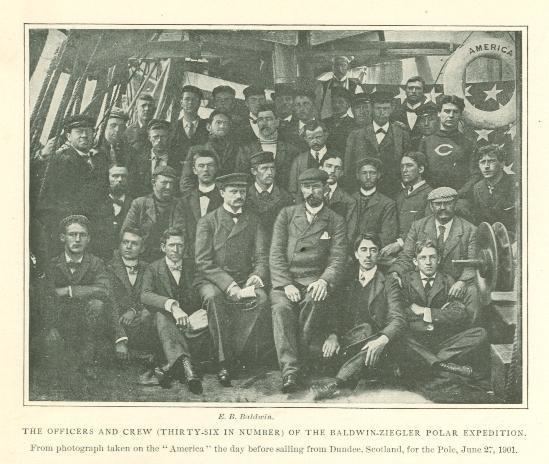Period 14 June 1903 – 1905 | ||
 | ||
The Ziegler polar expedition of 1903–1905, also known as the Fiala expedition, was a failed attempt to reach the North Pole. The party remained stranded north of the Arctic Circle for two years before being rescued, yet all but one of its members survived. The expedition, funded by William Ziegler and led by Anthony Fiala, departed from Tromsø, Norway, on June 14, 1903, aboard America. During their first winter, they deposited provisions and coal in Teplitz Bay, Rudolf Island, the northernmost island of Franz Josef Land.
Contents
Planning
Ziegler, who two years before had funded the 1901 Baldwin-Ziegler North Pole Expedition, selected Anthony Fiala, who was a photographer on the previous mission, to lead his second polar expedition. Fiala calculated that the food requirements of an eight dog team and driver would be at least 1100 pounds. This presented an issue, as the maximum sled load capacity was 600 pounds. He planned to use the ponies to carry the extra supplies, and to feed the dogs on horse meat when the supplies dwindled.
Isolation and rescue
In November 1903, when severe weather ensued, the ship broke up, destroying the provisions and coal. Some wreckage remained, but it disappeared in January 1904 following a storm.
The following spring, more attempts were made to reach the pole by traveling both east and west; however the conditions were too severe, and open water caused difficulties for the expedition. Provisions ran low, and the expedition headed south, eventually reaching depots at Cape Flora, Cape Dillion, and Camp Ziegler.
William Peters, who was second in command, utilized this time and led the crew in survey work, which resulted in improvements to maps and charts.
With the knowledge that rescue ships would be eventually sent to them, the expedition remained hopeful, though expedition leaders struggled to keep them in high spirits.
A rescue party, led by William S. Champ aboard the Terra Nova, sailed a course direct to the ice fields, and proceeded when the ice condition was favorable. On July 24, they encountered thick ice, causing the crew to doubt their ability to reach their destination. However the ship reached Palmi Island on July 28 and Cape Dillion the following day, where 6 expedition members were found. More members were found at Cape Flora, and the Terra Nova returned to Cape Dillion, where a sled party was organized, which brought back the crew.
